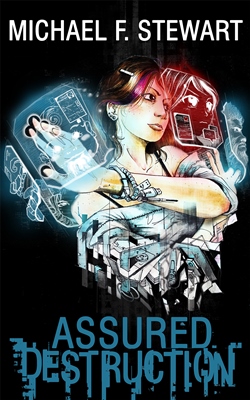 I read both of Mike Stewart’s Assured Destruction e-books towards the end of last year and thoroughly enjoyed them. You can read the reviews of Assured Destruction and Script Kiddie for my detailed thoughts on them, but suffice to say words like “excellent” and “well written” apply. When he told me he was doing a Kickstarter for the third book, I was excited. So, like I do, I wanted to find out more. I’ve asked him three questions and I hope you enjoy the answers.
I read both of Mike Stewart’s Assured Destruction e-books towards the end of last year and thoroughly enjoyed them. You can read the reviews of Assured Destruction and Script Kiddie for my detailed thoughts on them, but suffice to say words like “excellent” and “well written” apply. When he told me he was doing a Kickstarter for the third book, I was excited. So, like I do, I wanted to find out more. I’ve asked him three questions and I hope you enjoy the answers.
1) Being a geek, I’m a big fan of cyberpunk and stories involving tech. I’m not too sensitive to mistakes, depending on the story, but in a story like these getting the details right is very important. So far as I can tell you have done a very good job in the first two. Do you geek for a living and are thus able to avoid those pitfalls, is there a lot of research involved, or is it a bit of both?
If I could do life over, I’d be a coder. Why? Because it’s the closest you can get to being a real wizard. In what other field can the lines you write come alive on the screen, or in a robot’s actions? In what other field can you attack another system with programs/spells or protect yourself by putting up a firewall? Technology is moving into the realm of fantasy. That’s why I’m into it. So, do I geek for a living? No. I do however geekout. 🙂
I also have a deep interest in new media literacy and that includes new media risk (content, conduct, and contact). Kids need to understand the distributability and permanence of content. And they need to learn about how awesome technology is (let’s especially get more girls coding!). I’ve read hundreds of whitepapers on these issues and even presented to senate committee on the issues and opportunity of new media. With Jan I wanted to present a balanced view of those risks and opportunities.
2) One of the things I enjoyed about the first two novels is how “real” Jan’s life is. In addition to her mom’s health issues and the troubles of growing up in this wonderful modern age, she’s got her own unique problems. You don’t whitewash the world for the sake of a YA label. What limitations (if any) do you put on your works in this genre to keep it age appropriate and why did you opt to go as gritty as you did?
Sex and swearing. That’s about all I’ll keep out. Kids are reading far up in terms of age group. Oh, I also won’t write about kids committing suicide. There are studies that suggest suicide rates increase if kids read about their peers committing suicide.
All my writing is a little dark; I’m not sure I could keep that out of it, but Jan’s sense of humor helps me lighten the tone a bit (I hope—book three is intense).
3) You’re doing a Kickstarter for the release of the third book in the series. Have you crowd-funded before and what challenges are you facing with this campaign?
This is my first campaign, but I’ve released an app before and there are similarities in terms of trying to generate interest. That’s the big challenge; how do you get eyeballs to the campaign and once there, how do you convince them to make a pledge?
Some articles I’ve read have suggested that the keys are scarcity (i.e. be the first to get, or get one of a hundred XYZ), social proof (show people that others think your project has merit), and authority (why you? why am I the one to create this project).
But then it’s the same challenge with releasing a book too, isn’t it? You have to write the best hook you can, develop a brand around yourself, and spread the word.
In this case, I didn’t feel I had a choice. There’s a Kickstarter campaign IN the book, how could I not have one in real life?
Really appreciate the chance to post on your blog, Scott, and for your staunch support. 🙂
It’s a pleasure finding and supporting new writers. So, go to his kickstarter page and pledge whatever you can!
 The book is available
The book is available  I had the pleasure of
I had the pleasure of